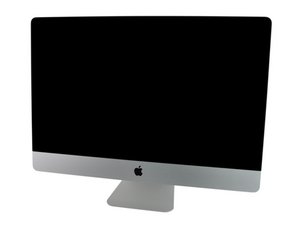https://support.apple.com/en-us/HT200553
This is Apple’s HOW-TO solve this problem.
I think it’s better to print out and do the testing according to Apple’s step-by-step plan.
==================================
If your Mac spontaneously restarts or displays a message that it restarted or shut down because of a problem
In rare cases, your Mac might spontaneously restart, become unresponsive, turn off, display a message that your computer restarted because of a problem, or display a message that you shut down your computer because of a problem.
In rare cases, your Mac might encounter an unrecoverable issue affecting all open apps. When this happens, your Mac must be restarted. This is sometimes due to what is known as a "kernel panic" because an underlying part of the operating system (the "kernel") has determined there is an issue that requires a restart.
If your computer experiences a kernel panic, a message may appear for a few seconds explaining that the computer has been restarted: "Your computer restarted because of a problem. Press a key or wait a few seconds to continue starting up." After a moment, the computer continues starting up.
In most cases, kernel panics are not caused by an issue with the Mac itself. They are usually caused by software that was installed, or a problem with connected hardware.
To help avoid kernel panics, install all available software updates until Software Update reports, "Your software is up to date." OS X updates help your Mac handle the kinds of issues that can cause kernel panics, such as malformed network packets, or third party software issues. For most kernel panics, updating your software is all you have to do.
Once your Mac restarts successfully, an alert message appears, "You shut down your computer because of a problem."
Click Open to re-open any apps that were active before you restarted. If you believe the issue may have been caused by one of the apps that you were using, click Cancel instead. If you don't click anything for 60 seconds, OS X automatically continues as if you had clicked Open.
Note: If your computer is unable to recover from the issue, it may restart repeatedly, and then shut down. If this happens, or if you see the "computer restarted because of a problem" message frequently, see the Additional Information section of this article for guidance.
Once you log in, OS X lets you know that, "Your computer was restarted because of a problem."
Click "Report…" if you want to see details related to the issue. You can also send these details to Apple. Sending these reports helps Apple to investigate the kinds of issues that cause panics to occur. Viewing the report may also provide additional clues as to what caused the issue.
Note: If you find the term "machine check" in the "Problem Details and System Configuration" field of this report, it may indicate a hardware-related issue. See the Additional Information section of this article for guidance.
Click OK to send the report to Apple, or close the window to dismiss the report. If the issue doesn't happen again during the next few weeks, the issue is likely resolved.
OS X Mavericks helps you correct kernel panics related to software you may have installed. If the cause of the kernel panic is known, Mavericks offers to help you disable its related software:
- If "More Info…" appears, click it to see more details about the issue, including possible workarounds or resolutions.
- Selecting the option to "Ignore" does not alter the software that may be related to the issue.
- "Move to Trash" moves software that is likely related to the issue to the Trash, but the Trash is not automatically emptied. When you select this option, an additional sheet appears:
- Click "Restart" to disable the software that may be responsible for the issue.
- When prompted, enter an administrator name and password.
- Click "Move to Trash".
- After restarting, the related software is in your Trash.
Click the Trash icon in the Dock to see which software was removed.
Contact the developer of the software to see if an update or more information is available.
- Empty the Trash if you want to permanently remove the third party software.
Read the following information to learn more about diagnosing and troubleshooting a recurring kernel panic.
Diagnosing a recurring kernel panic can be difficult. If you need help with this process, consider bringing your Mac to a Genius at an Apple Store or an Apple Authorized Service Provider for help. If you plan to visit an Apple Retail store, you can make a reservation (available in some countries and regions only).
Tip: To help diagnose recurring kernel panics, record the date and time it occurs, and any information that appears with the kernel panic message.
- Was the computer starting up, shutting down, or performing a particular task when the recurring kernel panic happened?
- Is the kernel panic intermittent, or does it happen every time you do a certain thing? For example, were you playing a particular game, or printing at the time?
- Does it occur only when a certain external device is connected, or a device is connected to a certain port?
To try to figure out if the issue is related to software or hardware, use the computer with a fresh installation of OS X on an external drive.
- Start the Mac from OS X Recovery.
If a kernel panic still occurs when started from Recovery, there is likely a hardware issue. See the "Hardware troubleshooting" section below for additional information.
- Open Disk Utility and use "Repair Disk" on your Mac's internal hard drive (named Macintosh HD by default).
Important: If Disk Utility is unable to repair the internal drive, you should back up your important data immediately and if possible, reformat the drive. Consider bringing the Mac to a Genius at an Apple Store or an Apple Authorized Service Provider for further diagnosis. Be sure to ask that, if the drive needs reformatting or replacing, they contact you about escalating your case to a special data recovery service. If you plan to visit an Apple Retail store, you can make a reservation (available in some countries and regions only).
- Connect an external drive with at least 10 GB of free space. Note: Make sure the external drive does not cause kernel panics, and is the only device on its USB, FireWire, or Thunderbolt port. Connecting the external drive and its cables to another Mac can help make sure the drive does not cause kernel panics.
- Install OS X on the external drive.
- Start up from the external drive.
- Use Software Update to install all updates until it reports "Your software is up to date."
- Don't install additional software on the external drive, but instead use the Apple applications to surf the web, view QuickTime movies, email, print, scan, and/or other activities. Continue using your Mac for the amount of time it would usually take for the issue to occur.
- If a panic occurs, select the "Hardware troubleshooting" section below to further diagnose the issue.
If a panic does not occur, select the "Software troubleshooting" section below article to further diagnose the issue.
Disconnect the external drive used in the above test to determine if the kernel panic is due to a hardware issue.
Go to the next section if you have no devices attached to your Mac.
- Turn off your Mac.
- Disconnect all peripheral devices. If you have a desktop Mac, make sure all you have connected is a display and Apple keyboard with Apple mouse or trackpad.
- Turn on your Mac.
- Use your Mac for the amount of time it would usually take for a kernel panic to occur.
- If a kernel panic does occur: Proceed the next section to check the internal RAM and third-party hardware.
If a kernel panic does not occur: Power down the Mac and connect one peripheral device at a time and test until a kernel panic occurs.
- Note: A combination of peripherals may be the cause of a kernel panic. Disconnect one peripheral at a time to see if it causes a kernel panic by itself. If the kernel panic does not occur, continue to add peripherals until you find the other peripheral needed to cause the kernel panic.
- Turn off your Mac.
- Reseat the Apple RAM, and remove third-party RAM and third-party internal hardware. If you do not have the Apple RAM that came with the system, reseat the third-party RAM.
- Turn on your Mac.
- Use your Mac for the amount of time it would usually take for a kernel panic to occur.
- If the kernel panic does not occur: The third-party RAM or internal third-party hardware may need to be replaced.
If a kernel panic does occur: Bring your Mac to an Apple Store, or an Apple Authorized Service Provider for service and support. Be sure to ask that, if the drive needs reformatting or replacing, they contact you about escalating your case to a special data recovery service. If you plan to visit an Apple Retail store, you can make a reservation (available in some countries and regions only).
Disconnect the external drive used in the above test to determine the kernel panic is due to a software based issue.
- Start the Mac from OS X Recovery and reinstall OS X on your Mac.
- Start from the installation of OS X you just created.
- Use Software Update to install all updates until it reports "Your software is up to date."
- Download and install any third-party software updates before reinstalling third-party software, especially drivers and kernel extensions.
Examples include:
- Virtualization software
- Drivers for add-on third party display cards
- Anti-virus software
- Networking software (especially software which enables third party network devices)
- Add-on file system support software; for example, software that lets your write to NTFS formatted media.
If the issue continues, you will need to erase and install OS X as follows:
- Start the Mac from OS X Recovery.
- Complete a disk image backup via Disk Utility of the internal drive to an external drive with enough free space.
- Erase the internal drive using Disk Utility.
- Install OS X.
- Start from the internal drive.
- Use Software Update to install all updates until it reports "Your software is up to date."
- Re-install your third-party apps and copy your user data from the disk image backup you created in step 2.
Note: Avoid copying data from the /Library and /System folders on your backup disk image.
You can check kernel panic logs for more information. The kernel panic text is added to the log after you restart the computer, assuming that you did not reset PRAM (the kernel panic text is stored in PRAM until you restart). In Mac OS X v10.6 or later, the logs are located in in /Library/Logs/DiagnosticReports.
Information that may aid developers in the investigation of a software issue may be in the log. The information may also provide clues as to what may have caused the kernel panic.
Understanding and Debugging Kernel Panics – This technote addresses kernel panics: what they are, how to read panic logs and how to debug the code that caused the panic.
Kernel Core Dumps – This technote explains how you can enable remote kernel core dumps used to collect data about the kernel panic.
Note: If you are a software developer, booter settings and debug flags may cause different symptoms for kernel panics.
Information about products not manufactured by Apple, or independent websites not controlled or tested by Apple, is provided without recommendation or endorsement. Apple assumes no responsibility with regard to the selection, performance, or use of third-party websites or products. Apple makes no representations regarding third-party website accuracy or reliability. Risks are inherent in the use of the Internet. Contact the vendor for additional information. Other company and product names may be trademarks of their respective owners.
Published Date: January 14, 2018

 3
3  2
2  1
1 




crwdns2944067:06crwdne2944067:0
Check cables what going hard drive...I have 2 wires cut and that booting is on and on.
crwdns2934271:0crwdnd2934271:0 Kari Kasslin crwdne2934271:0
Dear all, I had the same problem. In short: Over time three new graphic cards, three new power supplies (internally). Sudden restarts again and again. Had SSD Fan control running to no avail. Than I linked fan control to a software called "macs fan control". It allows to set fan speeds manually. Since I set CPU fan to 1200 rpm I had never ever a sudden restart again. Its like a new machine. Yes, power supplies may be faulty, as well as logic boards. But this piece of freeware made the business.
crwdns2934271:0crwdnd2934271:0 Stefan crwdne2934271:0
I have the same Problem now, can you tell that still work?
crwdns2934271:0crwdnd2934271:0 Albert crwdne2934271:0
Are you asking about disconnecting the built in wifi?
crwdns2934271:0crwdnd2934271:0 Bruno Rauch crwdne2934271:0
I have a 2012 Version running High Sierra and an external LG Monitor. I found out that when that monitor isn't connected to the iMac, it will not start up-gets to a point and then restarts. This happens over and over again. Has to be either the video card getting buggy or possibly some of the icons that populate the second monitor causing the computer to "freak out" not knowing what to do with those icons. Very strange.
crwdns2934271:0crwdnd2934271:0 jim Duke crwdne2934271:0
crwdns2934273:01crwdne2934273:0